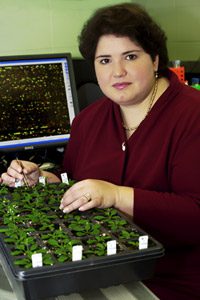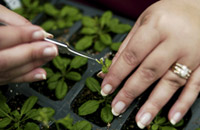Chileans Turn to Biologist for Science Behind Potential Crop Improvements
by Chris Bryant

Growing fruits and vegetables is big business in Chile. Dr. Katrina Ramonell is interested in the tiny science of microarrays — a technology enabling researchers to study thousands of genes simultaneously. Combining the two in an international class Ramonell recently taught could have large implications for the South American country’s crop industry.
Ramonell, an assistant professor of biological sciences at UA, recently gave an invited talk at the Catholic University of Chile in Santiago and taught a four-day, hands-on course there on microarrays. Fourteen students from Chile, Argentina, Brazil, Mexico and Uruguay were enrolled in the class.
Ramonell, who did her post-doctoral work at Stanford University alongside Dr. Shauna Somerville — one of those credited with developing microarrays, said the technology was first developed in 1995 and is considered, as science techniques go, still to be in its infancy.
“It literally is spots of DNA on a microscope slide, and each spot corresponds with one gene in the organism,” Ramonell said of microarrays. “Microarrays provide a way of looking at all the genes in a single organism at one time.” Prior to the advent of this technology, researchers worked on one gene or, at the most, a handful of genes per experiment, Ramonell said.
Microarrays can offer clues about a gene’s function. Such clues can help South American researchers, for example, gain insight into the genes involved in the ripening of fruits. Fruits naturally produce ethylene gas in ripening. And, in shipping, containment of the fruits can intensify the ripening, causing them to over ripen or even rot, Ramonell said.

The UA biologist said the class started with the basics. “I’m assuming no prior knowledge of microarrays,” Ramonell said, a few days prior to her departure. The plant researchers and plant pathologists enrolled will take back to their labs exposure to every part of the microarray process, she said.
“What we learn from the model organism Arabidopsis thaliana, we hope to be able to apply to crop plats,” Ramonell said. “They are much more complex on every level.”
Of particular interest to the UA researcher is the pathogen that causes powdery mildew, a widespread problem in many plants, including cucumbers, squash and even roses.
“The yield for whatever plant you are looking at plummets,” Ramonell said.
Finding solutions to the powdery mildew problem would reap much financially, Ramonell said. “The losses equated to powdery mildew worldwide exceed the losses attributed to all other pathogens combined.”
Further Reading